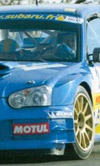Rally exhausts
 Not only is rallying an exciting sport to take part in and to watch, it places unusual demands on many of the components that make up the car and engine. Turbocharged engines in particular, with their anti-lag systems to aid transient response, place a lot of stress on components. In this regard, exhaust systems stand out as having to cope with more than their fair share of additional stress and hardship.
Not only is rallying an exciting sport to take part in and to watch, it places unusual demands on many of the components that make up the car and engine. Turbocharged engines in particular, with their anti-lag systems to aid transient response, place a lot of stress on components. In this regard, exhaust systems stand out as having to cope with more than their fair share of additional stress and hardship.
In addition to high levels of vibrations and shocks from jumps and so on, rally exhausts have to cope with the possibility of damage from rocks and gravel when drivers tend to hang the wheels of the car over the edges of ditches and gulleys to get the fastest line. An additional and unusual problem is the rapid quenching effect experienced when a very hot exhaust system is plunged into cold water when a stream is crossed.
The turbocharged engines naturally run with higher exhaust gas temperatures than their naturally aspirated counterparts, thus making the materials work closer to their limits. Anti-lag systems, often used in rallying, can take a number of forms, but a lot of anti-lag engine strategies rely on a lot of unburnt fuel entering the exhaust and burning there. This keeps the turbocharger spinning at low engine speeds and throttle opening without the engine producing power, by increasing exhaust mass flow rate.
In the absence of such systems and control strategies, the transient delay in the plenum reaching full boost pressure while the turbocharger accelerates makes the car difficult and unpredictable to drive. These anti-lag systems and control strategies create higher temperatures and pressures than would be normal in a turbocharged engine installation. The pressure spikes due to this abnormal exhaust combustion create additional stress in the exhaust.
There is a requirement therefore to place particular emphasis on weld quality. Given the lower quality of stainless steel materials compared to Inconel, attention to weld quality in the lower-grade material is critical if they are to last for any reasonable length of time. High-mileage failures of exhaust systems are often due to combustion of fuel in the exhaust.
Pat Barrett of Primary Designs, who has experience of the manufacture of rally exhausts for high-level competition, told me that the most common materials used for the production of competition rally exhausts are Inconel 625 and stainless steel. Inconel is a high-temperature material, beloved of many of the higher-budget race teams in many branches of motor racing, and there is a compromise to be struck between reliability and exhaust system cost. WRC cars tend to use Inconel, but competitors who aren't as well funded are more likely to choose a stainless steel system.
Beyond the turbocharger, exhaust temperatures are lower and the possibility remains of using a material that isn't so temperature resistant. While this means stainless steel for a lot of people, titanium is a realistic option for those who see reduction of mass as a priority.
Fig. 1 - Rallying imposes unusual demands on exhaust systems, including high internal temperatures and pressures, rapid quenching and impact damage
Written by Wayne Ward